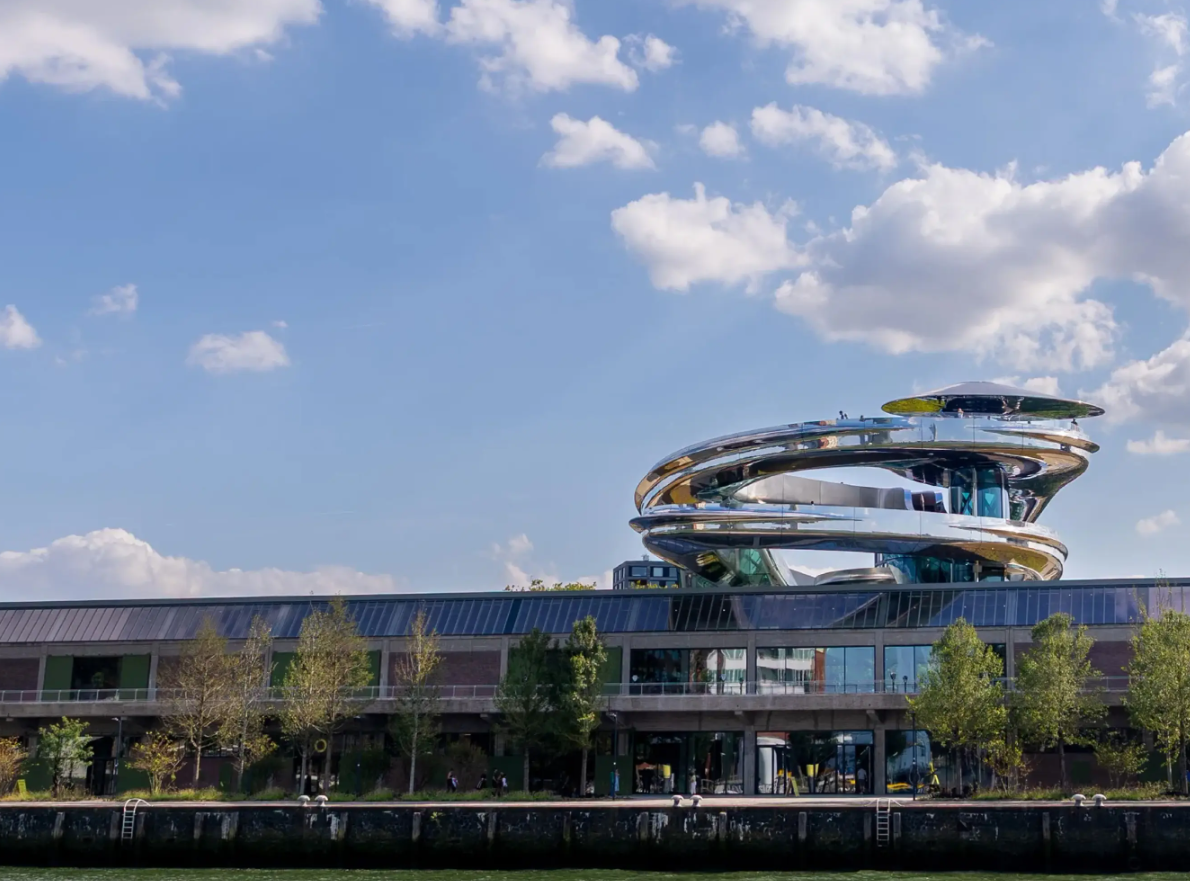In May 2025, a new art museum opened in the port of Rotterdam, focusing on the theme of migration and showcasing how people are on the move worldwide, both historically and today.
The museum covers approximately 15,000 square meters, features a permanent exhibition, and has a space for temporary exhibitions on the ground floor. The museum’s founding initiative stemmed from the desire to tell stories about migration. For decades, from 1891 onward, immigrants departed from Wilhelminakade along the river, across from the Rijnhaven (Rijnhaven), to destinations including America. They crossed the Atlantic Ocean aboard the Holland-America Line.[5] Their primary destination was Ellis Island in New York, which served as the gateway to the New World for immigrants.
A few weeks ago, my mother mentioned her eagerness to visit this museum, also referring to her own migration background, having left her homeland Indonesia as a young girl in the 1960s. Her family was among the last to arrive in the Netherlands because life in the Republic was fraught with obstacles such as daily discrimination and human trafficking.
I’m currently working on finding peace with my heritage. I don’t feel purely Dutch or purely Indonesian, but rather a blend that enriches my life. Instead of continuing to feel the pain of not being considered Dutch enough by a native Dutch person, I want to continue to embrace my difference through batik art and culture.
My mother is 72, and even though the nearest parking garage is a six-minute walk away, it’s far too far for her. That’s why I chose to rent a wheelchair to make the visit possible for her. There were times when she wanted to push the wheelchair herself, and we found the day educational, inspiring, and emotional.

Below information is from the website of Fenix.
Fenix is housed in a historic harbor warehouse dating from 1923. Once the largest transshipment warehouse in the world, it was designed by architect Cornelis van Goor and built for the Holland America Line. At that time, the warehouse was still called Warehouse San Francisco and is 360 meters long. In recent years, the warehouse has been restored and transformed into a museum. At the heart of the building, architect Ma Yansong added the Tornado: a double, spiraling staircase that spirals upwards to a viewing platform above the roof.
A turbulent history
During World War II, German troops blew up the quays. The warehouse was severely damaged. In 1948, a fire destroyed part of the building. Like the mythical phoenix, the warehouse rose from the ashes. The building was rebuilt, but as two separate structures. These were aptly named Fenix Warehouse I and Fenix Warehouse II.
A place of comings and goings
From the Fenixloods, you look out over the quays where millions of people once departed by ship. Just as many people arrived in the Katendrecht district and in Rotterdam, seeking a new home. This history inspired Ma Yansong of MAD Architects. He was the first Chinese architect to design a museum in Europe.
He designed a futuristic addition to the more than century-old warehouse: the Tornado. A work of art and observation deck in one. Two staircases, with a route of their own choosing, lead visitors to a panoramic deck above the roof. The Tornado’s rounded shapes make it appear as if in motion. The design thus reflects the bustle and history of the quays, where the lives of millions of men, women, and children changed forever.
Restored for the future
Over the years, the warehouse has served a variety of purposes and has been renovated several times. Various styles and elements that complemented each other or the building were added. Based on the advice of Bureau Polderman, the historic harbor warehouse was carefully restored. The facades and window frames were restored to their green color. The tranquil rhythm of the original design, with its concrete columns and characteristic windows, was reinstated.
Stories of the people who helped build it
Hundreds of engineers, welders, and carpenters are working together on the restoration and construction of Fenix. Behind every bolt, screw, and plank is a person with a story. For example, meet Asgeir, who came from Norway to the Netherlands for love. Or discover the story of friends Alan and Remsley. While Remsley longs for his life as a fisherman on Curaçao, Alan has found his new home in Rotterdam.

All artworks tell their own story. Whether it’s an artwork made of plastic bags (degeneratingly called a “Turkish suitcase”) or a giant embroidered tapestry depicting the artist’s family history, these works reflect a personal connection or experience with the topic of migration.
People migrate for various reasons: a better future, war, or natural disasters. It’s not a contemporary movement. Unfortunately, migration also encounters considerable resistance and misunderstanding. No one will simply leave their homeland, and in the current negative political climate surrounding migration, it’s wise to show understanding for the migrant’s situation.
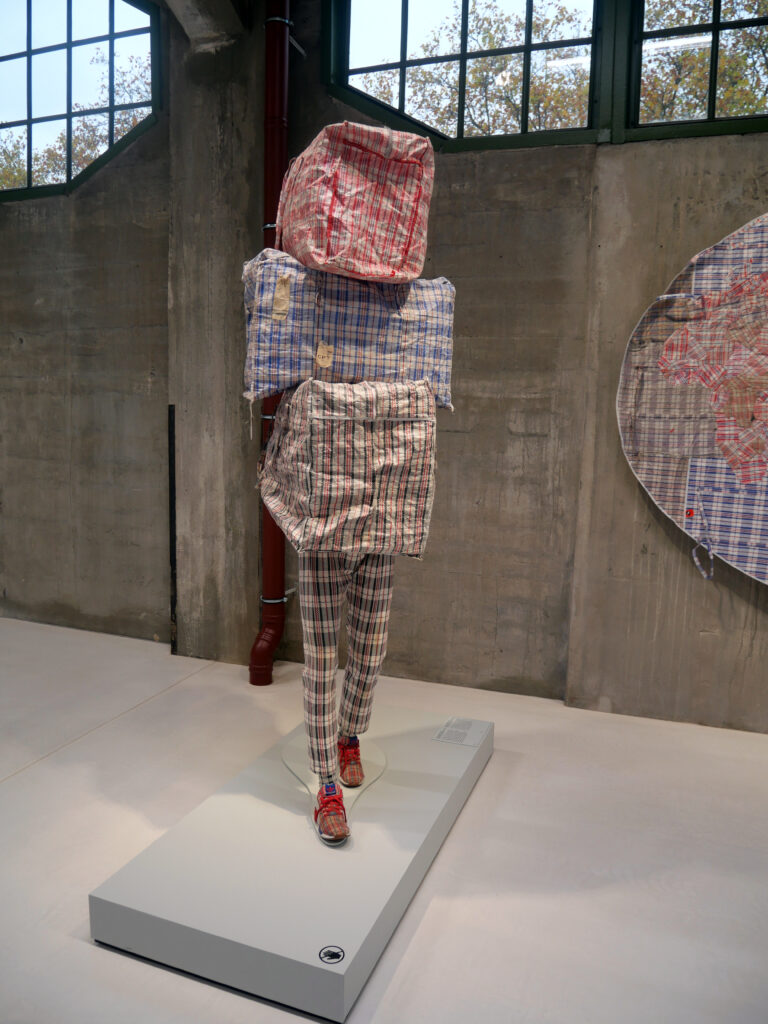

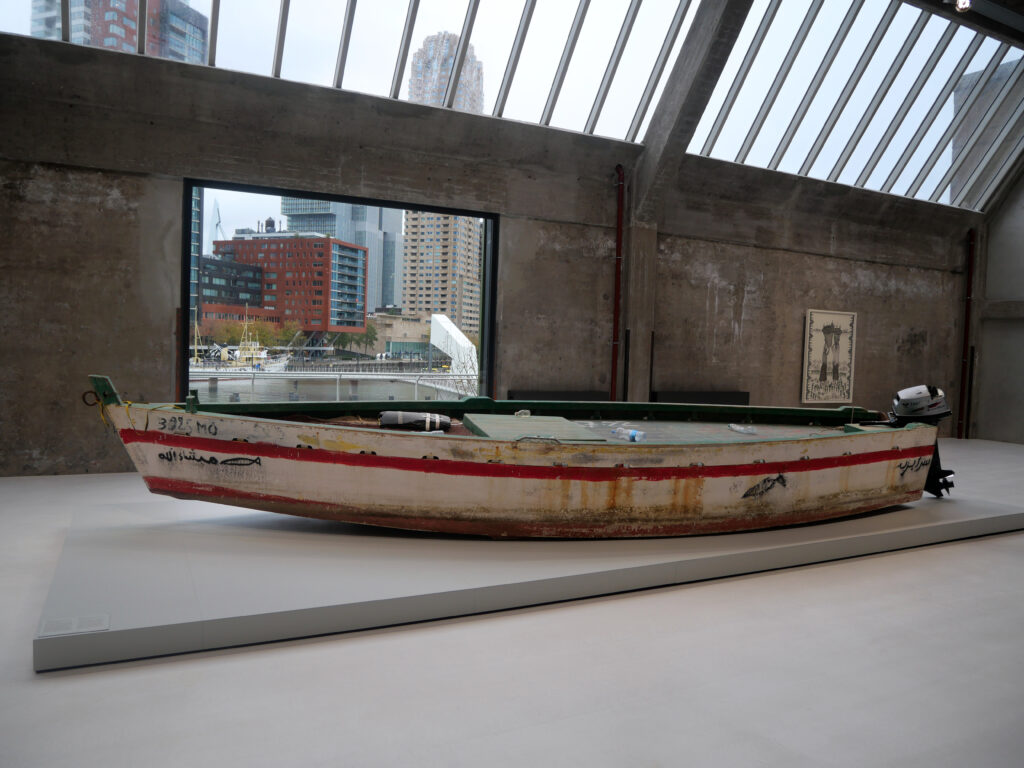

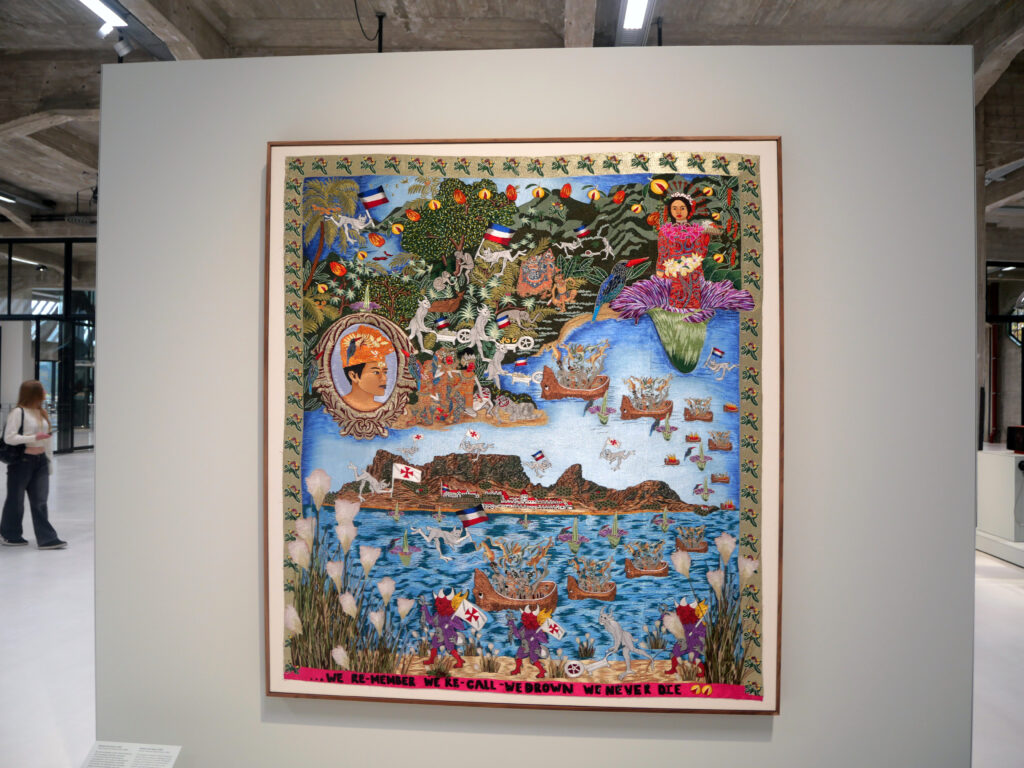
I was very intrigued by the tapestry above, made by Thania Petersen (South Africa 1980).
With this tapestry, Thania Petersen tells her family history, which begins in Indonesia. At the top, she embroidered nutmeg, a precious Indonesian spice that played an important role in trade. The medieval monsters depict European sailors. 150 years ago, they shipped Petersen’s ancestors from their homeland to Cape Town, recognizable by Table Mountain.
I previously wrote that while the enslaved people of Suriname are more widely known in Dutch history, the enslaved people of Southeast Asia receive almost no attention when discussing the horrors of colonization. And that saddens me. This piece gives me hope that their stories will also become more widely known.
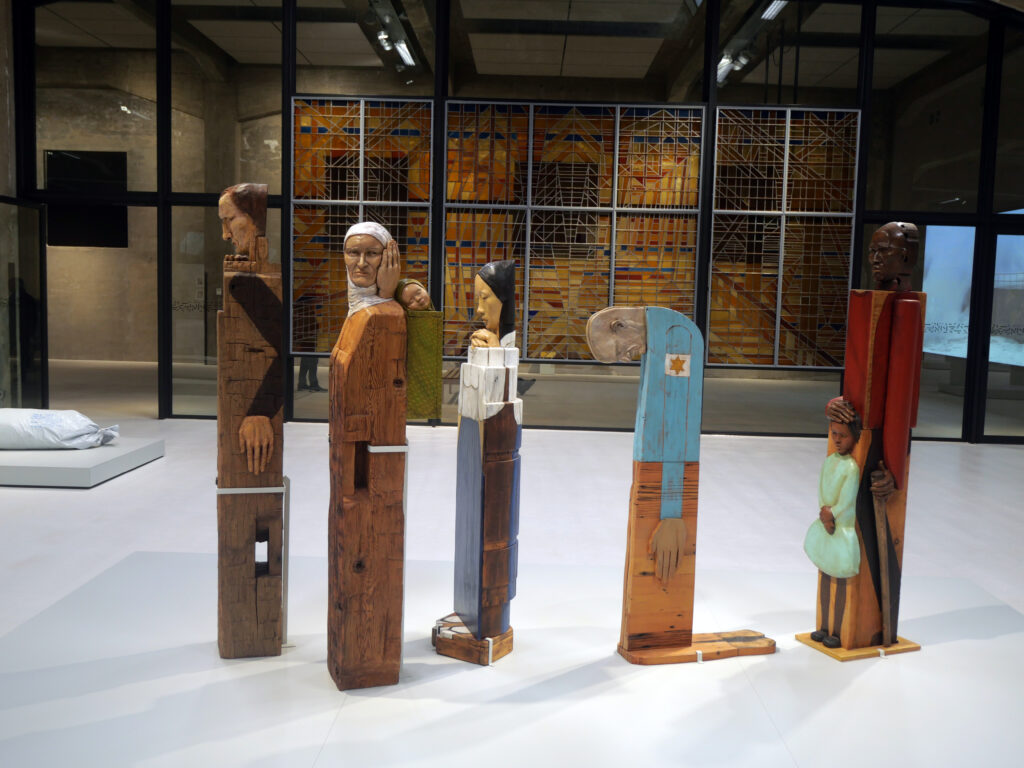
These figures are carved from wooden Railroad ties and represent groups of people who have been denied entry to the United States throughout history. They include Africans, Jews, Japanese Americans, and Muslims. The figure in the front, still unknown, symbolizes the next group barred from entering the Land of the Free.
This art installation gave me an ominous feeling. Many of these groups have had serious consequences. The first figure is an African woman with a child, symbolizing those who were not transported to America as free men. Then came the Jews who wanted to flee Nazism in Europe. Antisemitism wasn’t limited to Europe; Hitler had many admirers in America.
During World War II, America targeted a new enemy: the Japanese Americans. They were imprisoned in camps, and their property was destroyed or stolen.
9/11 brought the next enemy into the Americans’ sights: Muslims. Every Muslim had to answer for the actions of a small group of extremists.
The final figure is still unknown, the next group to face America’s wrath. For me, it’s the Latins. Every day, groups of people are dragged from their cars or homes and locked up in detention centers as if they had committed a crime. Their only crime is being Latin and wanting a better future for their children. Whiteness isn’t the foundation of America; First Nations people were already there. But with their nationalistic preaching, they want to make white people the ultimate deity, at all costs.

On the ground floor, a suitcase maze has been built using suitcases donated by migrants. An audio tour guides you through migration stories about love and farewell, about coming home and feeling at home, about homesickness and longing.
This part of the museum became the most emotional part for my mother. She recognised the suitcase she had when packing up a select few items to take with her to the Netherlands. The smell of leather brought her back to her old room in Makassar and brought her to tears.
I still remember the story of how she had a table clock in her house, and when it became known they were emigrating, her neighbor bought it. From that moment on, she heard the clock’s mechanism ticking on the other side of the wall, and she realized she would leave everything in the house behind. A thought that made her very sad as a child.
When my mother dies, she won’t die on the land where she was born. And that brings her a great sense of loss.
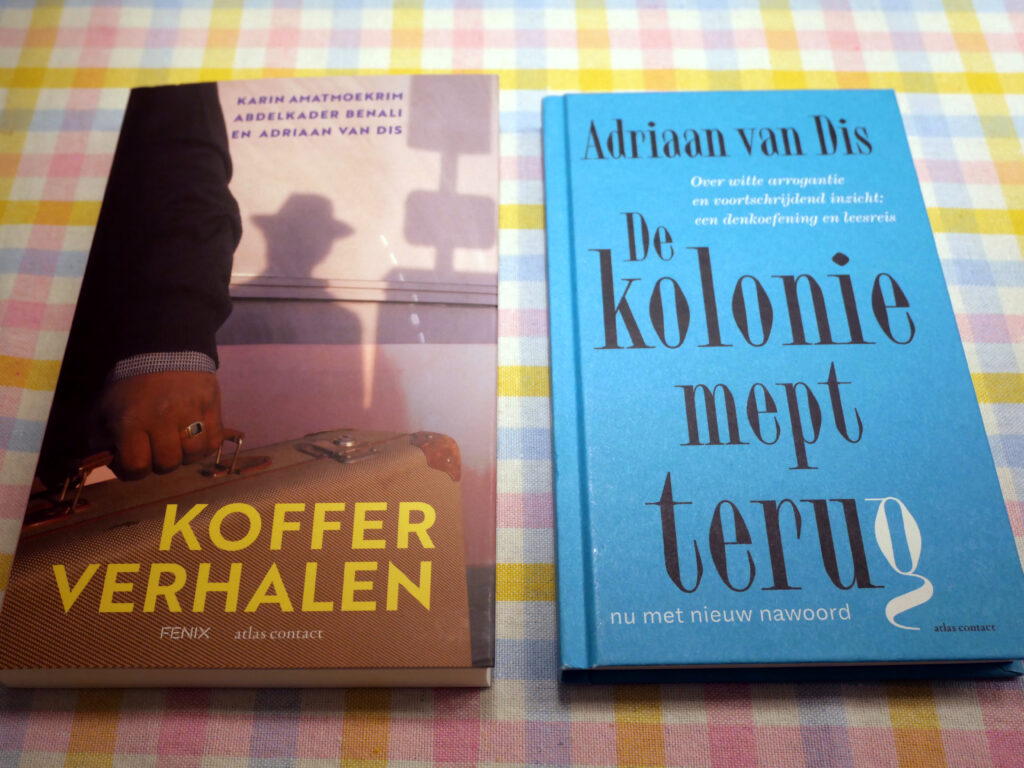
I bought two books in the museum shop. “Suitcase Stories,” which tells the stories of 10 migrants. For me, it’s important to read the stories of other migrants as well. Because every journey is special.
“The Blue Book” is a reflection on colonization. “The Colony Strikes Back” – On White Arrogance and Progressive Insight: A reflection and reading journey.
The wounds inflicted by forced displacement, Western expansionism, and divide-and-rule politics have not yet healed. Europe is under scrutiny, the worldview dictated by white power is shifting, and the descendants of the colonized are raising their voices. Adriaan van Dis—born in an Indonesian background—has been following the postcolonial debate at home and abroad for years. A reading and thinking experience that ultimately prompted him to look at this era differently.
I think it’s good that people are coming to different insights, because the Dutch East India Company era brought the Netherlands great wealth, but at the expense of people overseas.
I highly recommend this museum. It’s best to go on a dry day, as the Tornado is easy to climb. Visit the café and try delicious international dishes like hummus and kofte. And be sure to check the calendar; they offer workshops and you can dine with the neighbors.

